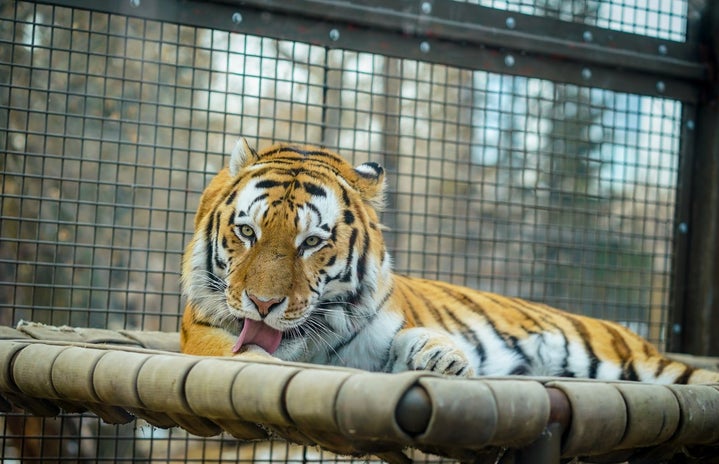Hey all you cool cats and kittens! If you haven’t already seen Netflix’s newest hit, The Tiger King, I’m sure that you have heard about it—or at least seen a meme or two. This crazy docuseries follows zookeeper Joe Exotic and his fellow animal lovers in their battles to be the top big-cat brand in the country. Particularly, it focuses on his feud with Carol Baskins (who definitely killed her husband) and their various schemes to knock each other out of the game. The Tiger King is everything you could ask for to entertain you during quarantine; it is extravagant, funny, and mysterious, with excellent characters and crazy twists. However, the end of the series takes a step back from its jokes and addresses a real issue: the dwindling numbers of tigers that exist in the wild, and the lack of effort that we have shown to help save this species of big cat.
There are an estimated 3,890 tigers living in the wild today. To put this number into perspective, the population of Las Cruces is around 100,000. That means that there are 25 times more people living in our city alone than there are tigers living naturally throughout the entire world. The Tiger King also brings up the fact that there are more tigers living in captivity here in the United States than there are wild tigers. Overall, things aren’t looking up for our wild striped friends.
Tigers aren’t the only animals that are growing critically endangered, either. Many species of rhinoceros, orangutan, sea turtle, leopard, and elephant are also reaching critical numbers, and humans are, for the most part, to blame. We are also the only ones capable of reversing the damage and bringing these species back up to their natural numbers.
Of course, people always talk about saving endangered species, but one can’t help but to ask—why? Humans put forth thousands of dollars each year trying to save species like the tiger, but what purpose do they serve besides them looking pretty and majestic when we go to visit them at the zoo? Why not put our money towards building houses in underdeveloped countries, or some other kind of humanitarian act, and let nature take its course?
Scientists believe that thousands of species of plants and animals go extinct every year. We need to protect them because once they are gone, there is no way for us to get them back. I think it would be sad to describe to my grandchild what tigers and elephants looked like if they would never have a chance to see a real one in person. Beyond that, conserving the ecosystem is also in our own best interest as a species. Take, for example, phytoplankton. This endangered species produces an estimated 80% of the Earth’s oxygen. If we were to allow them to go extinct, we would have less oxygen to breathe—and, obviously, humans must be able to breathe to survive. We could always try to chemically engineer our own oxygen, of course, but that would end up being far more expensive than trying to save the creatures that already do this for us.
Besides being ethical and trying to preserve the balance of nature, we should also try to save endangered species because we never know when we might need them. Picture this: there is some species of moss that exists only in the Amazon rainforest, and we let this moss go extinct. Three years later, some disease starts spreading around the globe—kind of like COVID-19, but much more deadly. Humanity doesn’t know this, but the only possible cure for the disease came from the moss that will never exist again. This is all theoretical, of course, but we never know.
So what can we do to help save endangered species like the phytoplankton, the tiger, and the mysterious humanity-saving moss? There are countless organizations that are dedicated to protecting endangered species, and they are always in need of donations. However, even if you don’t have money to give away, there are other ways that you can protect these species. The first is to be educated. Unless you are Joe Exotic himself, you probably don’t have tigers living in your backyard. However, there are plenty of at-risk species that live here in New Mexico, like the bees that pollinate our flowers. There are even species such as the Sacramento Mountain Salamander that exist only in New Mexico, and they rely heavily on us to be educated and protect them. The next thing that you can do is be eco-friendly. Use your recycling bin and don’t litter. Every plastic bag that you recycle is one more plastic bag that won’t kill a marine animal when it finds its way to the ocean.
If we are all more aware and eco friendly, we can make significant contributions to the lives of endangered species around the world—including the tiger. I encourage all of you to do what you can to reduce the mark that you make on our planet, leaving it healthier and more sustainable for future generations. In doing this, we can come together to save thousands of animals from extinction—and we will all be Tiger Kings.



